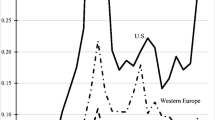Abstract
In the aftermath of the Global and Financial Crisis, between 2013 and 2015, the Portuguese government revoked four holidays for both public sector and private employees. We test whether the revocation had an effect on labour productivity in state-owned enterprises (SOEs) in Portugal. Moreover, we also study whether such effects are different taking into account the SOEs managed by the Central Government or the Local and Regional Governments. Our results show that revocation of holidays did not impact labour productivity for either central or local and regional government managed SOEs. Though revocation of holidays espoused to improve productivity, the policy seems to have served a ceremonial purpose, but not an economic one.

Source: authors’ calculations.
Similar content being viewed by others
Notes
Naturally, it is not straightforward to assess the productivity in some industries (i.e. tertiary sector), In addition, if one used output per hour (for which we do not have the data for the sample at hand), to measure labour productivity, the fact that a worker is asked to work more of fewer days, can still have a different response from the labour force. Indeed, workers might react differently in terms of intensity and productivity.
References
Abramov, A., A. Radygin, R. Entov, and M. Chernova. 2017. State ownership and efficiency characteristics. Russian Journal of Economics 3(2): 129–157.
Baum, A., Medas, P., Sy, Mouhamadou, Soler, A. 2020. “Managing Fiscal Risks from State-Owned Enterprises”. IMF Working Paper No. 20/213.
Brown, J., J. Earle, and A. Telegdy. 2006. The productivity effects of privatization: Longitudinal estimates from Hungary, Romania, Russia, and Ukraine. Journal of Political Economy 114(1): 61–99.
González-Páramo, J., and P. de Cos. 2005. ”The Impact of Public Ownership and Competition on Productivity. Kyklos 58(4): 495–517.
Huber, J., Jara, M., Kim, H., Ter-Minassian, T., Wagner, R. 2019. Fixing State-Owned Enterprises: New Policy Solutions to Old Problems. Inter-American Development Bank.
IMF. 2020. “State-Owned Enterprises: The Other Government”, Fiscal Monitor, May 2020, International Monetary Fund, Washington D.C.
Lardy, N. 2019. The state strikes back: The end of economic reform in China?. Peterson Institute for International Economics.
OECD. 2017. Economic Surveys, Portugal. February 2017. OECD.
La Porta, R., F. Lopez-de-Silanes, and A. Shleifer. 1999. Corporate ownership around the world. Journal of Finance 54(2): 471–517.
Pérard, E. 2009. Water Supply: Public or Private? Policy and Society 27(3): 193–219.
Reinsberg, B., T. Stubbs, A. Kentikelenis, and L. King. 2020. Bad governance: How privatization increases corruption in the developing world. Regulation & Governance 14(4): 698–717.
Richmond, C., Benedek, D., Cegar, B., Dohlman, P., Hassine, M., Jajko, B. & Pula, G. 2019. Reassessing the Role of State-Owned Enterprises in Central, Eastern, and Southeastern Europe (No. 19/11). International Monetary Fund.
Syverson, C. 2011. What Determines Productivity? Journal of Economic Literature 49(2): 326–365.
Vernon, R., Aharoni, Y. (Eds.). 2014. State-Owned Enterprise in the Western Economies (Routledge Revivals). Routledge.
Vining, A., and A. Boardman. 1992. Ownership versus Competition: Efficiency in Public Enterprise. Public Choice 73: 205–239.
Wilkinson, P. 2017. “10 Anti-Corruption Principles for State-Owned Enterprises: A Multi-Stakeholder Initiative of Transparency International.” Transparency International.
World Bank. 2017. Who Sponsors Infrastructure Projects? Disentangling Public and Private Contributions. Washington, DC: World Bank.
Acknowledgements
We thank two anonymous referees for their very useful suggestions. The authors acknowledge financial support from FCT – Fundação para a Ciência e Tecnologia (Portugal) and for national funding through research Grants UIDB/05069/2020 and UIDB/04521/2020. The opinions expressed herein are those of the authors and not necessarily those of their employers.
Author information
Authors and Affiliations
Corresponding author
Additional information
Publisher's Note
Springer Nature remains neutral with regard to jurisdictional claims in published maps and institutional affiliations.
Rights and permissions
About this article
Cite this article
Afonso, A., Guedes, M.J. & Patel, P.C. Labour Productivity in State-Owned Enterprises. Comp Econ Stud 63, 450–465 (2021). https://doi.org/10.1057/s41294-021-00148-1
Accepted:
Published:
Issue Date:
DOI: https://doi.org/10.1057/s41294-021-00148-1




